



MEGAN FOX (holding AMANDA SEYFRIED'S breasts): "These things.These are like smart bombs. Okay? You point them in the right direction and shit gets real."
Jennifer's Body, Twentieth Century Fox, 2009, written by Diablo Cody

ἔλαφος φιλίας καὶ πῶλος σῶν χαρίτων ὁμιλείτω σοι·
ἡ δὲ ἰδία ἡγείσθω σου καὶ συνέστω σοι ἐν παντὶ καιρῷ,
ἐν γὰρ τῇ ταύτης φιλία συμπεριφερόμενος πολλοστὸς ἔσῃ.Cerva carissima et gratissimus hinulus;
ubera eius inebrient te omni tempore,
in amore illius delectare iugiter.A lovely hind, a graceful doe.
Let her breasts satisfy thee at all times;
may you be captivated always by her love.Proverbs 5:19 [note]
Ἑξήκοντα τελεῖ Χαριτὼ λυκαβαντίδας ὥρας,
ἀλλ᾽ ἔτι κυανέων σύρμα μένει πλοκάμων,
κἠν στέρνοις ἔτι κεῖνα τὰ λύγδινα κώνια μαστῶν ἕστηκεν...C
HARITO has completed sixty years, but still the mass of her dark hair [κυανέων... πλοκάμων] is as it was, and still upheld by no encircling band those marble-white cones [λύγδινα κώνια] of her breasts [μαστῶν] stand firm...Philodemus of Gadara, Φιλόδημος ὁ Γαδαρεύς, Book V, "The Amatory Epigrams," 13, The Greek Anthology, Volume I, Books 1-6, Translated by W.R. Paton [The Loeb Classical Library, Harvard University Press, 1916, 1993, pp.134-135], translation modified -- Philodemus was a Roman period Epicurean, with many entries in The Greek Anthology, many of whose books have been found in the Villa de Papri at Herculaneum.
ἡ δὲ κἀκ τριῶν τρυπημάτων ἐργαζομένη ἐνεκάλει τῇ φύσει, δυσφορουμένη ὅτι δὴ μὴ καὶ τοὺς τιτθοὺς αὐτῇ εὐρύτερον ἢ νῦν εἰσι τρυπώη, ὅπως καὶ ἄλλην ἐνταῦθα μίξιν ἐπιτεχνᾶσθαι δυνατὴ εἴη.
And though she made use of three openings [τρυπήματα], she used to take Nature [φύσις] to task, complaining that it had not pierced her breasts [τιτθοί] with larger holes so that it might be possible for her to contrive another method of copulation [μῖξις] there.
Procopius, Procopius VI, The Anecdota or Secret History, translated by H.B. Dewing [Loeb Classical Library, Harvard University Press, 1935, pp.108-109], speaking of the Empress Theodora in her days as a courtesan (ἑταῖρα).

Eve Babitz (1943-2021) and Marcel Duchamp (1887-1968) playing chess,
Pasadena Art Museum, Julian Wasser, 1963Behind them "The Bride Stripped Bare by Her Bachelors, Even (The Large Glass)," La mariée mise à nu par ses célibataires, même (Le Grand Verre), 1915-1923, now in the Philadelphia Museum of Art.
One of the advantages of having done this walk [in Ghent] before the eighteenth century would be to avoid the freakish carving [the Mammelokker] then put over the entrance of the city gaol in the basement of City Hall,
which featues the pointlessly seedy Roman story of Old Cimon, who is imprisoned with no food but stays alive because when his daughter visits him she secretly breastfeeds him. How anyone imagined this was a good topic for a carving I have been unable to discover...
Simon Winder, Lotharingia, A Personal History of Europe's Lost Country [Farrar, Straus and Giroux, 2019, pp.93-94] -- [note].
To me, women seem surprisingly deficient in fascination for their own breasts. No woman would ever think the same thing about a man and his penis. In the 1991 movie, L.A. Story, Steve Martin remarks that, if he were a woman, "I'd just stay home and play with my breasts all day." Women may suspect that is exactly what men already would do with their organs. But while Bill Clinton gave rude directions to Paula Jones, how often does a woman tell a man, "Play with my breasts"?
Ἐγκλινοβάραγγος (Enklinobarangus)
The narrator writes of the breasts of one of her friends: "I'd like to eat Hélène Lagonelle's breasts as he [the lover] eats mine in the Chinese town where I go every night to increase my knowledge of God. I'd like to devour and be devoured by those flour-white breasts of hers."
Viv Groskop, Au Revoir, Tristesse, Abrams Press, 2020, review of L'Amant by Marguerite Duras; pp.120-121; brackets in original.
A strange thought came to him: why, among all animals, in the long course of the world, had the breasts of the human female alone become beautiful? Was it not to the glory of the human race to have made woman's breasts so beautiful?
Yasunari Kawabata (1899-1972), "House of the Sleeping Beauties," 1961, House of the Sleeping Beauties and Other Stories, translated from the Japanese by Edward G. Seidensticker, 1969 [Vintage International, Vintage Books, 2017, p.27].

 |
|---|
| "Woman With a Book," 1932, Pablo Picasso (1881-1973); model, Picasso's mistress, Marie-Thérèse Walter (1909-1977) |
Humans are unusual in this respect. At maturity, human females develop permanent large swollen glands which are especially prominent because they are carried high on the chest in an upright posture. We might as well say: you can't miss them. This circumstance betrays their function as sexual organs and signals and not just sources of milk [note].
The constancy of the signal goes along with the sexual availability of the females apart from ovulation -- while most female mammals are only sexually responsive during estrus. In form and function human breasts are thus perhaps the most distinctively human organs of the human body. It is hard to say what else comes close.
The human foot is unique among mammals, which goes along with humans being the only truly bipedal and upright primates. The foot, however, does not ordinarily represent any kind of signal to other humans -- although the female foot, in particular dress, does also become a sexual signal. It is hard to say exactly how much of a signal it was before styles of shoe developed to deliberately feature and display it -- from the somewhat awkard and painful high heels, to the horrifying Chinese tradition of foot-binding. We might wonder, however, at the theory of V.S. (Vilayanur Subramanian) Ramachandran (b.1951) that, since the neurology for the foot is adjacent in the brain to that for the genitals, stimulation of the feet might spill over to the latter. That would explain a lot.
Other features of human beings that have been identified as particularly human, such as reason or language, are not betrayed by externally visible organs.  The combination of bare skin and flowing hair is itself unique among primates, and it does have a sexual component, distinctively, with beards (etc.) on men, and women able to grow longer hair on their heads [
The combination of bare skin and flowing hair is itself unique among primates, and it does have a sexual component, distinctively, with beards (etc.) on men, and women able to grow longer hair on their heads [ note].
note].
A woman's hair is enough of a sexual signal, even when relatively short in style, that religious anhedonia, as in Islām, may require that it be covered in public. Yet for all the anhedonic tendencies that may have existed in historical Christianity, hair was a relatively minor concern (perhaps to be partially covered in church), while keeping the breasts concealed has often aroused public controversy. It is thus noteworthy that these most distinctively human organs, which are furthermore particularly characteristic of the female, represent something about sexuality that is also most distictively human.
But it is not just sexuality. Hecuba does not bare her breasts to the Greeks, or female Egyptian mourners at funerals, to send sexual signals. Breasts also represent motherhood and so tenderness and compassion, by which Hecuba hoped, futilely, to move the hearts of the Greek victors, who were murdering children. This is something that seems to have become lost in modern life, perhaps because, ironically, the obsessive concealment of the breasts has actually intensified their sexual signal [note].
 Human cultures, even those that take some care to conceal the genitals of both males and females, have had different attitudes about the display of the female breast. The Egyptians, among major civilizations, seem to have been rather free in this respect; and the exposure of two breasts, one, or none seems more a matter of fashion than of general considerations of modesty or religious prohibition. We see variations of dress over Egyptian history and even within the same periods. At the same time, we know of the sexual appeal of Egyptian breasts because of references to them in Egyptian love poetry.
Human cultures, even those that take some care to conceal the genitals of both males and females, have had different attitudes about the display of the female breast. The Egyptians, among major civilizations, seem to have been rather free in this respect; and the exposure of two breasts, one, or none seems more a matter of fashion than of general considerations of modesty or religious prohibition. We see variations of dress over Egyptian history and even within the same periods. At the same time, we know of the sexual appeal of Egyptian breasts because of references to them in Egyptian love poetry.
 The most extraordinary women's costume in history may have been that of the Minoan civilization on Crete. We get what appears to be a full Victorian era, floor length dress, with sleeves and covered shoulders, but with the breasts left entirely bare. The remaining images do not show variations as in Egyptian dress. There was an enduring, standard style.
The most extraordinary women's costume in history may have been that of the Minoan civilization on Crete. We get what appears to be a full Victorian era, floor length dress, with sleeves and covered shoulders, but with the breasts left entirely bare. The remaining images do not show variations as in Egyptian dress. There was an enduring, standard style.
This has posed problems for historical reenactment, such as we find in documentaries on Greek or Minoan history. Minoan women simply cannot be shown, with historical accuracy, without being bare breasted.  "Family friendly" venues must then do violence to accuracy, lest young minds be traumatized and corrupted by a bit of tender, womanly flesh.
"Family friendly" venues must then do violence to accuracy, lest young minds be traumatized and corrupted by a bit of tender, womanly flesh.
Curiously, this never seemed to worry the National Geographic Society, which even well before the promiscuous Sixties produced images of modest but accurate form -- but the Society had always tolerated images of nudity when found in non-European contexts, to the delight of young Eisenhower era boys with subscriptions to National Geographic Magazine [note].
While an image such as we see above left from Knossos represents the breasts in modest and minimal form, we get something rather different at left,  from the "Minoan Pompeii," the city on Santorini, now called Ἀκρωτήρι, Akrōtíri (from Modern Greek Ακρωτήριο, Akrōtírio, Classical Greek Ἀκρωτήριον, Akrōtḗrion, "cape, promontory; mountain peak; extremity"), that was buried by the great eruption in the 17th century BC.
from the "Minoan Pompeii," the city on Santorini, now called Ἀκρωτήρι, Akrōtíri (from Modern Greek Ακρωτήριο, Akrōtírio, Classical Greek Ἀκρωτήριον, Akrōtḗrion, "cape, promontory; mountain peak; extremity"), that was buried by the great eruption in the 17th century BC.
Here we see a Minoan woman in an unusual pose, bending over. Because of this, her breasts are pendulous, hanging free, something I have not seen in other ancient, let alone modern, depictions of Minoan costume. I think that such free movement is what modern sensibilities would find the most disturbing about this form of dress. Modern dress specifically aims to hold the breasts steady -- leaving naive young men with the impression that breasts are like muscle. Proper breasts are supposed to be hard and rigid, like stone -- that alone makes Classical art endurble, without erotic overtones.
The Greeks and Romans in general favored modesty, but sexual exposure of the body seems to have been more a matter of humor or humiliation than of anything more serious. The nudity of male Greek athletes, although a source of Hellenic pride, was not approved of by the Romans, nor did it extend to female Greek athletes. Female dress seems to conceal the breasts as much as the genitals, unlike India, where the breasts are typically exposed in Classical costume. Then, later, especially during the Hellenistic Age, there was also a growing sense that the naked body, beginning with males and then extending to 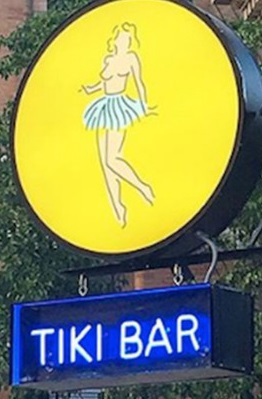 females, was a thing of beauty, and its portrayal was taken up at a most serious level in art.
females, was a thing of beauty, and its portrayal was taken up at a most serious level in art.
It is consequently a little hard to imagine Greek or Roman "indecent exposure" laws, also because, although the gods themselves might have some modesty, there was a religious dimension to sexuality that rendered sexual organs sacred and numinous. Thus, when the courtesan, Φρύνη, Prýnē exposed her breasts (at least) to the Athenian jury, this resulted in a law prohibiting such conduct, but she was nevertheless acquitted, in part out of fear, we are told, of her divine patroness, the goddess Aphroditē. The Athenians would be reminded of the danger of crossing the goddess from sources like the Hippolytus of Euripides.
The monotheistic religions introduced a nudity taboo, which historically might be enforced with violence or legal sanctions. This originated in the cultural milieu of Judaism, and was not unique to it, but it then was especially propagated through the daughter religions of Judaism, namely Christianity and Islam. It makes the most sense in Christianity, which was far more world-denying than the other two and involved practices (more characteristic of Hinduism or Jainism) of asceticism, austerities, and mortifications of the flesh. Sexual organs and sexual arousal could then be regarded as dangerous sources of temptation away from the requirements of piety. This could be regarded as a matter of positive evil. All three religions, however, contain some element of religious anaesthesia.
With modern visual culture, and especially since the advent of Hollywood and Hugh Hefner, a sort of neo-paganism has emerged, as described by Camille Paglia, with considerably more freedom in terms of images, even if there is little retreat, at least in the United States, of "indecent exposure" laws. The female breast, as a compromise between fully concealed sexuality and exposed genitals, has perhaps taken on the full force of representing the erotic beauty, sacrality, and numinosity that was more diffusely embodied by the Greeks and Romans, or even in Hinduism and traditional Japan.
Thus,  Mardi Gras in New Orleans, while featuring no parading phalluses (tourist attractions in some Japanese villages), nevertheless is now an acceptable venue (more or less) for women to flash their breasts -- Americans consequently get accused of a fixation on breasts. In Brazil, actually nudity was finally prohibited in Mardi Gras parades -- but then body paint was ruled as the equivalent of clothing [note].
Mardi Gras in New Orleans, while featuring no parading phalluses (tourist attractions in some Japanese villages), nevertheless is now an acceptable venue (more or less) for women to flash their breasts -- Americans consequently get accused of a fixation on breasts. In Brazil, actually nudity was finally prohibited in Mardi Gras parades -- but then body paint was ruled as the equivalent of clothing [note].
Where the nudity taboo is still strongly felt, this sort of behavior, and the accessibility of images of the breast, buttocks, etc., provokes the sort of fear and outrage that we might expect from Mediaeval religion, but it may also bespeak the fearful power of numinosity itself. After all, sacred sexuality does not just feel good or titillate; it is both fascinating and terrifying.
 The nudity taboo as a prohibition of the unclean, polluted, or unholy is one thing; but nudity and sexuality as beautiful, sublime, and sacred can also be matters of prohibition. I find it hard not to think that the Egyptians or the Greeks did a better job of balancing all this than a lot of later cultures and religions, but it is definitely a job of cultural wiring that involves some powerful and dangerous currents -- as Paglia also appreciated. How to do this right in a modern context, especially with powerful influences from those who don't want to do it at all, is daunting.
The nudity taboo as a prohibition of the unclean, polluted, or unholy is one thing; but nudity and sexuality as beautiful, sublime, and sacred can also be matters of prohibition. I find it hard not to think that the Egyptians or the Greeks did a better job of balancing all this than a lot of later cultures and religions, but it is definitely a job of cultural wiring that involves some powerful and dangerous currents -- as Paglia also appreciated. How to do this right in a modern context, especially with powerful influences from those who don't want to do it at all, is daunting.
Meanwhile, these organs are not just visual signals in the sexual context; they are sensitive and active in the human sexual response. For women, there seems to be a wild range in the kind and extent of the sensitivity. Some women may find their breasts merely ticklish, while others can even achieve orgasm from their stimulation. Maxim magazine once helpfully reported the results of a survey that 8.8% of women answer that what is "most likely to bring [them] to orgasm" is "nipple sucking and fondling" [April, 2011, p.76, boldface added].
This strikes me as a surprisingly large segment of the population. Otherwise, most women may find the stimulation of nipples or breasts arousing but then prefer to move the locus of attention. Men may also find that stimulation of their own nipples can effect arousal, but such attention may also be judged unmanly. How this all works seems to draw less scientific attention than the sexual responses of the genitals proper.
The Egyptian word for "breast," The words for "milk" in Latin (lac, genitive lactis), Greek (gála, γάλα, gen. gálaktos, γάλακτος -- yes, this is the origin of "galaxy," galaxías, γαλαξίας, the "Milky Way"), and Arabic (ḥalab, حَلْب) are all from different roots. The coincidence of the mlg roots, however, is one of the fragments of evidence for the common origin of the Indo-European and Semitic language families. The case remains weak for this relationship, but its truth would not be particularly surprising. Nevertheless, we do know of the geographical proximity of the families, and the possibility of the borrowing of this root must be considered [note].
Curiously, the name of the sacred shrine in Mecca, the كَعْبَة, the Kaaba (Kaʿbah, in the feminine gender), is from a verb (كَعَبَ, kaʿaba) that means "to be full and round." Thus, another word from the same root, كَاعِب, kāʿib (an active participle), means "well-developed, full and round, swelling (bosom); having swelling breasts, buxom (girl)." The plural of this, كَوَاعِب, kawāʿib (a "broken" or irregular plural), can mean "buxom girls" [Hans Wehr, A Dictionary of Modern Arabic, Cornell University Press, 1966, p.831]. This usage might be comparable to "broads" in dated English slang.
There is another word in Arabic, mufallik, مُفَلِّك (the form of a passive participle), which means "a girl with round breasts." This is from the root فَلَّكَ, fallaka (Form II, which doubles the medial consonant), which means "to have round breasts." So mufallik literally means "round breasted."
Curiously, "roundness" seems to have suggested the sky; so فَلَك, falak, is the "celestial sphere," and فَلَكِؾ, falakī (with an adjectival ending), "astronomical" or "astronomer." Perhaps by gazing at both sky and breasts, astronomers made the connection.
The form of the breast is a mystery of the ages. One might think that a modern artist, like Renoir, would be carefully to do it correctly; but, no, the middle figure in "The Great Bathers" (Les Grandes Baigneuses) at right, has breasts that float as though they are in water. Or perhaps Renoir wants to convey that the figure is moving and that the breasts have bounced up. In a Beverly Hills art gallery, I once saw a statue of a nude women doing a hand-stand. The artist had neglected to observe that the breasts would no longer hang towards the figure's feet, up in the air, but towards her head, near the floor. I doubted that the statue had been done from a model actually doing the hand-stand, or the sculptor might have noticed the problem. I used to see nude life-drawing classes at the University of Hawai'i, where in the '70's the Art Department and the Philosophy Department were in the same building (George Hall); but no models (female or otherwise) were ever doing hand-stands.
The young modern male may find this completely bewildering. Growing up in a culture where bare breasts are not part of daily life, and deceived by the modern brassiere (let alone breast implants), which is usually designed to hold breasts to fixed positions and shapes, that free breasts will move and change shape, and certainly to the extent that they can, may then be quite startling. Indeed, this contributes to the magnification of a sexual curiosity that otherwise will already exist, let alone an urge for tactile examination.
Even if the historic artist understands that breasts move and that their shape is not a perfect cone or hemisphere, there is then the challenge of portraying both the natural variation and the curving geometrical shapes that will be involved. It is then difficult to know whether the problem was (1) an inability to portray such curves, (2) a rejection of them for what were regarded as more ideal shapes, or (3) a squeamishness about devoting the attention and close study to the organs that their faithful representation would have required. In Ancient and Mediaeval art, where women's bodies may have been regarded as imperfect or unwholesome, a preference for ideal shapes and impatience or aversion for the necessity of close study may have been factors. Also, the tradition of nude modeling, familiar to the Greeks, who nevertheless for long had trouble accepting the beauty of the female body, may not have existed for much of the Middle Ages. Modern artists, however, have no excuse on most of these issues. One does wonder about Michaelangelo (1475-1564). His female nudes look like they have muscular male bodies with the artificial addition of shapeless and distorted breasts. The explanation for this may be the lack of nude female modeling or the idealization of the male body, either from Hellenizing, Christianizing, or homoerotic influences.
Women's clothing has long addressed this issue, but also with interesting consequences. Thus, Mediaeval and early Modern Claudia Schiffer on the runway in a corset may swell up and bounce with every step and every breath, even while her breasts are still supported. The brassiere can avoid these effects, as the corset itself could eliminate the décolletage that binding the breasts together had previously produced. All the more interesting, then, has been the development of "push-up" bras that can reproduce both the upward swelling and the décolletage. These may only be worn on special occasions, for special effect, but they make it clear that the erotic manipulation of the shape of the breasts, if not their movement, is something of which women, as well as men, remain strongly aware. If the shape of the breast has defeated most of the history of art, the consistency of the breast still defeats modern materials science. The silicone (a polymer of silicon with carbon, hydrogen, oxygen, etc.) that has been used for breast enhancement and reconstruction may seem soft enough, but it is still too rigid to duplicate the natural flesh of the breast. Also, silicone may become hard over time, which is the opposite of the development of natural tissue and also may become increasingly uncomfortable, if not painful, to the woman (especially if scar tissue forms around implants).
The straight injection of silicone, as done for the legendary Carol Doda (1937-2015) in 1964, was later rejected because of problems with the silicone migrating to other tissues (although apparently not a problem for Doda herself). The use of bags for silicone, or later for saline solutions, however, introduced an extra element of unnatural shape, as the curvature of the bag is visible where the natural breast may be smooth. Meanwhile, some people mistakenly or inadvertly say "Silicone Valley" instead of "Silicon Valley" to refer to the area in California around Santa Clara and San Jose where many computer and other high tech companies are located. "Silicone Valley" would more properly mean Broadway in San Francisco's North Breach district, where strip clubs, including Doda's (the Condor Club), have historically been located.
A nice personal, cultural, historical, and artistic examination on the breast is The Breast Book -- An Intimate and Curious History -- Attitude, Perception, Envy & Etiquette, by Maura Spiegel & Lithe Sebesta [Workman Publishing, New York, 2002].
There are many other AI YouTube channels now featuring beautiful women, not always with exaggerated breasts; and this seemed to be a recent phenomenon, with the "Luxe Horizon B Dash" videos dated from no more than from December 2024, a few weeks before I found the channel. However, although many beautiful women remain at YouTube, I have noticed recently that the channels and videos with the particularly large breasted women seem to have disappeared. As though there has been an erotic purge. I see no comment about this, but many of the videos I bookmarked are no longer there, including the "Luxe Horizon B Dash."
Gears, clocks, and piping appear in unexpected places, like on clothing, generally with the look of bronze fabrication. Instead of glasses, we get goggles, often with some sort of mechanism behind the lenses. The clothing for women, in turn, is mainly based on the bustier, which has a Victorian feel, but which otherwise rarely includes much other clothing -- with very un-Victorian skin and legs showing.
A favorite aesthetic, otherwise, looks to be science fiction space travel. We may even get the sense that low or zero gravity is what is responsible for the large breasts on women. Perhaps the lack of gravity stimulates growth, even as it mitigates the burden of heavy breasts. The footnote images are mostly both space travel and Steampunk aesthetic. Below, however, is an example of what is simply a beautiful interior garden scene, with waterfalls. Along with the beautiful women, these are not lacking and may be extraordinarily detailed. A similar image, below, an enclosed greenhouse garden, one of my favorites, is from the "Echo Beyond" YouTube channel, whose images I have used for the Anaesthetic Feminism page. The page otherwise has Steampunk women, but without the exaggerated breasts.
Below is the image of a room in the "Steampunk Symphony, An AI Short Film," at the "AI Retro Vision" YouTube channel. This video has most of the Steampunk elements, with a couple of differences. One is that many of the images show large rooms whose design seems much more Rococo than Victorian. They would fit perfectly into the 18th Century -- except for the occasional (steam) automobile, whose design is just as Rococo, matching the color and tone of the rooms. Otherwise, there may not even be Steampunk elements in the images.
We might also wonder about the view out the window. We seem to be at altitude, and this is most likely to be in one of the anti-gravity airships that populate Steampunk videos. However, the room hardly seems like the stateroom on an airship but would fit better into one of the palaces that look like the venues of the other room images in the video. So perhaps the altitude is on a mountain. Again, no Steampunk elements in this image.
Another difference of this video from other Steampunk videos is that the women are (mostly) wearing more clothing than just a bustier, also without exaggerated breasts. Indeed, although the clothing, as below, is very elaborate, and with Steampunk elements like a clock and gears in the hat, this would not raise much alarm in the 1890's. It is very beautiful fabric, colors, and feathers. There are even matching gloves. This is characteristic of the video.
Camille Paglia has said that when a lot of art became deliberately ugly, beauty moved over to fashion. Now, fashion itself, while not exactly ugly, has often gotten rather weird -- and it has nowhere the prominence it did in the "supermodel" era of the 1990's. Beauty, in turn, may have moved to these Youtube videos, where it is suddenly abundant and exuberant, dragging a fair amount of fashion, art, and even music with it.
The effect is much like what I remember of the music videos that were originally featured on MTV back in the early 1980's. Eventually MTV seemed to move to reality TV shows. If you want music videos, however, they are all at YouTube; and now the AI videos are essentially a new art form. You don't needs artists or bands. Anyone with a computer can create AI videos, with anything or anyone in them.
Shame, Beauty, and the Ambivalence of the Flesh
The Erotic as an Aesthetic Category
Classical Indian Women's Dress
The New Friesian Theory of Religious Value
Philosophy of Science, Geology & Astronomy The Arabic expression, أَلنَّهْدَانِ, ʾan-nahdāni, "the two breasts," like the Greek phrase τὼ ἀνθρωπίνω μαστώ, tṑ anthrōpínō mastṓ, Other familiar duals in Arabic are نَهْرَيْن, Nahrain, the "Two Rivers," meaning Mesopotamia, especially in the North, from نَهْر, Nahr, "river," and صَحَّتَيْن, ṣaḥḥatain, "twice healthy," a drinking toast, from صَحَّة, ṣaḥḥah, "health" (the first vowel is an "i" in Classical Arabic) -- a word that also turns up in a greeting, كَيْفَ ٱلصَّحَّة, kayfa [colloquial kīf] iṣ-ṣaḥḥah, "How is the [i.e. your] health?" (parallel to كَيْفَ ٱلْحَال, kayfa l-ḥāl, "How is your condition?" i.e. "How are things?" -- see in Persian here).
There are a number of words for "breast" in Arabic. We have seen the definite dual of نَهْد, nahd, "breast, bosom" [Hans Wehr, A Dictionary of Modern Arabic, Cornell University Press, 1966, p.1003].

 or
or  (using the ideogram or determinative
(using the ideogram or determinative  ), with the root mnd, looks to be a cognate of malaja, مَلَجَ, "to suck, suckle," in Arabic. Since the j in Arabic is a g in Proto-Semitic (*mlg), we have the coincidence of the similar Indo-European root *melg that turns up in Latin mulgere, "to milk,"
), with the root mnd, looks to be a cognate of malaja, مَلَجَ, "to suck, suckle," in Arabic. Since the j in Arabic is a g in Proto-Semitic (*mlg), we have the coincidence of the similar Indo-European root *melg that turns up in Latin mulgere, "to milk," 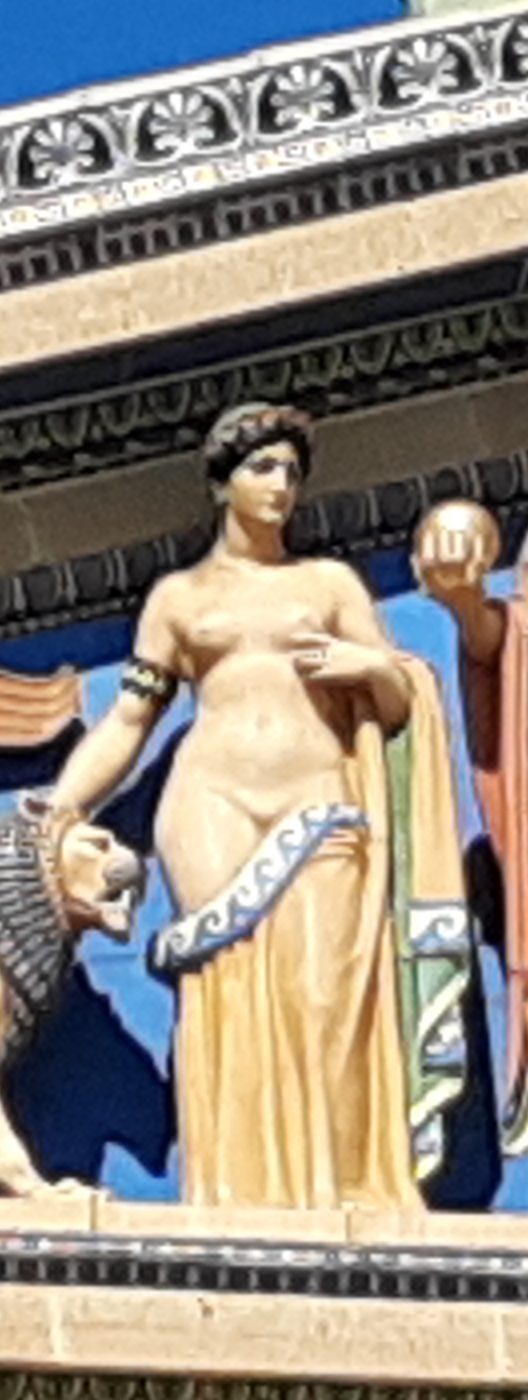 and, indeed, in the English word "milk" itself. A Proto-Semitic *mlg root looks like the zero-grade Ablaut variation of an Indo-European *mlg, *melg, *molg root, whose purest morphological remnants seem to be in Greek, although not with this root. Between Egyptian, Arabic, Latin, and English, we have the identity of the breast, what it does, and what it produces.
and, indeed, in the English word "milk" itself. A Proto-Semitic *mlg root looks like the zero-grade Ablaut variation of an Indo-European *mlg, *melg, *molg root, whose purest morphological remnants seem to be in Greek, although not with this root. Between Egyptian, Arabic, Latin, and English, we have the identity of the breast, what it does, and what it produces.

 Ancient, Mediaeval, and even many Modern artists, across cultural lines, have typically been completely unable to represent the breast in its natural shape -- or rather "shapes," since there is great variation. But a spherical symmetry that defies gravity has been the default representation, despite this really corresponding to no natural form -- except as the breast floats in water, producing an extraordinary effect that otherwise seems to draw little attention.
Ancient, Mediaeval, and even many Modern artists, across cultural lines, have typically been completely unable to represent the breast in its natural shape -- or rather "shapes," since there is great variation. But a spherical symmetry that defies gravity has been the default representation, despite this really corresponding to no natural form -- except as the breast floats in water, producing an extraordinary effect that otherwise seems to draw little attention.  At least the Egyptians, in their ideogram for breast, as shown, represent the organ hanging straight downward, which is the only way, in air, that any such a symmetry is likely to be evident -- although actual women probably spend little time bent right over or naked on their hands and knees.
At least the Egyptians, in their ideogram for breast, as shown, represent the organ hanging straight downward, which is the only way, in air, that any such a symmetry is likely to be evident -- although actual women probably spend little time bent right over or naked on their hands and knees.
 This is possible, given that we may infer movement to escape the water about to be splashed by the woman on the right, but it is not otherwise obvious from the painting. While there is a significant tradition in photography and art of the close study of movement in the human body, this does not extend to the movement of the breasts, for which the only real resource (as for floating breasts) is in pornography.
This is possible, given that we may infer movement to escape the water about to be splashed by the woman on the right, but it is not otherwise obvious from the painting. While there is a significant tradition in photography and art of the close study of movement in the human body, this does not extend to the movement of the breasts, for which the only real resource (as for floating breasts) is in pornography.
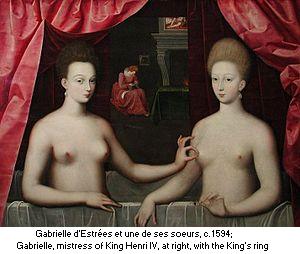 Two things may have confused or inhibited artists through history. One is that, although younger and smaller breasts are firmer than older and larger ones, there nevertheless is nothing to give the breast a rigid structure, unlike the buttocks with its underlying large muscles or the penis with its erectile tissue. The breast is soft and pliable and assumes a shape that generally is a function of its size, weight, and orientation -- with variations produced by other factors of its structure.
Two things may have confused or inhibited artists through history. One is that, although younger and smaller breasts are firmer than older and larger ones, there nevertheless is nothing to give the breast a rigid structure, unlike the buttocks with its underlying large muscles or the penis with its erectile tissue. The breast is soft and pliable and assumes a shape that generally is a function of its size, weight, and orientation -- with variations produced by other factors of its structure.

 The brassiere has been popular among women because, after all, loose and bouncing breasts can be a painful nuisance (although popular pornography video). As Katy Perry says in "One of the Boys": "And I tape these suckers down/'Cause they just get in my way" [One of the Boys, Published by When I'm Rich You'll Be My Bitch (ASCAP), administered by WB Music, 2008]. Although the organs are unnamed, it is hard to know what else they could be; and this is consistent with the frustration that Perry expresses, at that point in the song, with being female. Of course, the point of the song is that she changes her mind, and "That I just wanna be/One of the girls/Pretty in pearls/Not one of the boys" -- she is lucky that no one persuaded her to get "gender affirming surgery" in the meantime [note].
The brassiere has been popular among women because, after all, loose and bouncing breasts can be a painful nuisance (although popular pornography video). As Katy Perry says in "One of the Boys": "And I tape these suckers down/'Cause they just get in my way" [One of the Boys, Published by When I'm Rich You'll Be My Bitch (ASCAP), administered by WB Music, 2008]. Although the organs are unnamed, it is hard to know what else they could be; and this is consistent with the frustration that Perry expresses, at that point in the song, with being female. Of course, the point of the song is that she changes her mind, and "That I just wanna be/One of the girls/Pretty in pearls/Not one of the boys" -- she is lucky that no one persuaded her to get "gender affirming surgery" in the meantime [note].
 blouses might be laced up with bodices to hold the breasts steady, as the later corset does in lifting and holding them. The noteworthy result of either of these fashions, however, can be to squeeze the breasts upward. The curvature that is especially prominent on the underside of the naked breast is transfered to the top.
blouses might be laced up with bodices to hold the breasts steady, as the later corset does in lifting and holding them. The noteworthy result of either of these fashions, however, can be to squeeze the breasts upward. The curvature that is especially prominent on the underside of the naked breast is transfered to the top.

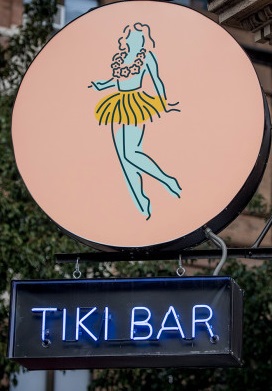 The introduction of "teardrop" bags to mimic more of the natural shape of breasts does no more than betray the inability of silicone to shape itself realistically under the force of gravity. Since silicone is too rigid, and a saline solution is, well, just water, there is no safe artificial material currently available that has the consistency of natural flesh. Nature continues to defeat both art and science.
The introduction of "teardrop" bags to mimic more of the natural shape of breasts does no more than betray the inability of silicone to shape itself realistically under the force of gravity. Since silicone is too rigid, and a saline solution is, well, just water, there is no safe artificial material currently available that has the consistency of natural flesh. Nature continues to defeat both art and science.

 In the footnotes to this page there are multiple images of women with large breasts, as at left. These are computer generated AI images, mostly from a YouTube channel "Luxe Horizon B Dash," which seems to specialize in videos of large breasted women, sometimes absurdly large breasted. While American men are often accused of having a breast fixation, this YouTube channel is from Japan, where we also notice very large breasts in anime and manga art, despite the reputation of Japanese women themselves having somewhat smaller breasts. But I have seen a gaijin (外人) woman much like the one at left on the Ginza, hair and all, in the company of a much smaller Japanese man.
In the footnotes to this page there are multiple images of women with large breasts, as at left. These are computer generated AI images, mostly from a YouTube channel "Luxe Horizon B Dash," which seems to specialize in videos of large breasted women, sometimes absurdly large breasted. While American men are often accused of having a breast fixation, this YouTube channel is from Japan, where we also notice very large breasts in anime and manga art, despite the reputation of Japanese women themselves having somewhat smaller breasts. But I have seen a gaijin (外人) woman much like the one at left on the Ginza, hair and all, in the company of a much smaller Japanese man.
 Among the YouTube videos there are aesthetic genres, including very common "Steampunk" features, in which 19th Century technology is elevated to science fiction levels, with anti-gravity airships, for instance, that nevertheless appear to run on steam power and spew smoke -- but no one seems to know how the wheels are driven on steam engines.
Among the YouTube videos there are aesthetic genres, including very common "Steampunk" features, in which 19th Century technology is elevated to science fiction levels, with anti-gravity airships, for instance, that nevertheless appear to run on steam power and spew smoke -- but no one seems to know how the wheels are driven on steam engines.





 Return to Text of "All Living Things in Seven Kingdoms"
Return to Text of "All Living Things in Seven Kingdoms"
Copyright (c) 2005, 2007, 2008, 2010, 2011, 2012, 2013, 2014, 2016, 2017, 2018, 2019, 2020, 2021, 2022, 2023, 2024, 2025 Kelley L. Ross, Ph.D. All Rights Reserved

Mammae Humanae, Note 1

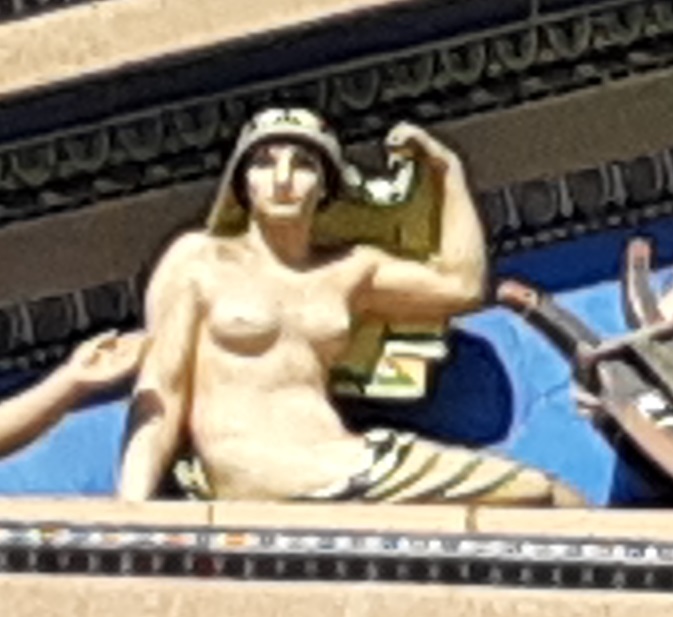 "the two human breasts," is in the dual number. This is archaic in both Arabic and Greek, even in the Classical languages, but it is sometimes convenient, as here, and it survives in some fixed forms. Thus the name of the state of Baḥrain, بَحْرَيْن, means "Two Seas," apparently meaning the salt water of the Persian Gulf and the fresh water springs that were discovered in ancient times on the actual bed of the Gulf near Baḥrain. This made it a valuable stopping point on the sailing route to India, and it now has been positively identified as what the Sumerians called "Dilmun," which became a mystical place in recollection (as in the Epic of Gilgamesh).
"the two human breasts," is in the dual number. This is archaic in both Arabic and Greek, even in the Classical languages, but it is sometimes convenient, as here, and it survives in some fixed forms. Thus the name of the state of Baḥrain, بَحْرَيْن, means "Two Seas," apparently meaning the salt water of the Persian Gulf and the fresh water springs that were discovered in ancient times on the actual bed of the Gulf near Baḥrain. This made it a valuable stopping point on the sailing route to India, and it now has been positively identified as what the Sumerians called "Dilmun," which became a mystical place in recollection (as in the Epic of Gilgamesh).
 There is an apparent anomaly here, as Baḥrain in the dual and the nominative case could be بَحْرَانِ, Baḥrāni. However, modern spoken Arabic has defaulted to the accusative case in all forms where this remains identifiable (as happened to Latin in the transition to the later Romance languages), which in the dual for Baḥrain would be بَحْرَيْنِ, Baḥraini. The final "i" is then also lost in the spoken language.
There is an apparent anomaly here, as Baḥrain in the dual and the nominative case could be بَحْرَانِ, Baḥrāni. However, modern spoken Arabic has defaulted to the accusative case in all forms where this remains identifiable (as happened to Latin in the transition to the later Romance languages), which in the dual for Baḥrain would be بَحْرَيْنِ, Baḥraini. The final "i" is then also lost in the spoken language.

| Arabic words for "breast" |
|---|
 , nahd , nahd |
 , thadan , thadan |
 , kuʿb , kuʿb |
| mufallik, مُفَلِّك |

The most intriguing word for "breast" in Arabic may be that from the root verb كَعَبَ, kaʿaba, which means "to be full and round" [p.830]. From this comes the name, as we will see above, of the sacred shrine in Mecca, the كَعْبَة, the Kaaba (Kaʿbah).
Other derivatives about breasts are discussed above, but here let's just look at كُعْب, kuʿb, "breasts, bosom" [p.831]. If this has a collective meaning of "breasts," then perhaps the dual would not be correct with it. Wehr does not list a plural for this form, as he does for both nahd (نُهُود, nuhūd, "breasts") and thady (أَثْدَاء, ʾathdāʾ, "breasts"). Of course, this probably means that the plural form is regular, unlike the "broken" or irregular plurals of the other words. The regular plural would be كُعْبُونَ, kuʿbūna, "breasts" (in the Classical nominative ending).
Why are there at least three different words for "breast" in Arabic? Of course, in English there are dozens of words for breasts, but almost all of those are colloquial, metaphorical, vulgar, or obscene. The terms examined here in Arabic are all from the formal, Classical language. We might wonder if, unlike the anaesthetic moralism of fundamentalist Islam, the language retains a memory of a bit more appreciation for physical beauty and pleasure.

The Egyptian word above,  , "two breasts," is also in the dual, which was also relatively archaic in Egyptian, as later in Greek and Arabic.
, "two breasts," is also in the dual, which was also relatively archaic in Egyptian, as later in Greek and Arabic.
The most curious thing about this word is not its number, but its root. The ordinary word for "breast" in Egyptian seems to be  or
or  , whose great interest will be examined in the text above. I came across
, whose great interest will be examined in the text above. I came across  in the English to Middle Egyptian Dictionary, by Bill Petty [Museum Tours Press, Littleton, Colorado, 2016, p.33]. This is listed as an entry under "bosom," whose main entry, however, is
in the English to Middle Egyptian Dictionary, by Bill Petty [Museum Tours Press, Littleton, Colorado, 2016, p.33]. This is listed as an entry under "bosom," whose main entry, however, is  .
.
There is no infomation in Petty's books to determine why the roots of these words -- bn and šꜢšꜢ -- should have the meanings we see here. And Petty's other books mean his Hieroglyphic Dictionary [2012] and Egyptian Glyphary [2012], where we do not find these words or the relevant roots at all.  They also do not occur in Gardiner's Egyptian Grammar [Oxford, 1927, 1964]. So this is all very mysterious, although it is nice to see some variety of words for "breast" in Egyptian, which we would expect.
They also do not occur in Gardiner's Egyptian Grammar [Oxford, 1927, 1964]. So this is all very mysterious, although it is nice to see some variety of words for "breast" in Egyptian, which we would expect.
The image here, despite the absurdly large breasts, is one that, for some reason, I find particularly attractive. Since this is clearly supposed to be in space, the image may reinforce the possibility that large breasts are stimulated or rendered tolerable by low gravity, although even in low gravity one might think they would interfer with the ordinary activities of life. Actual women with gigantomastia, natural or surgically enhanced, may use them to generate income -- although recently some airline passengers complained that the large breasted woman seated next to them was spilling over into their space. Perhaps the crew could have asked if there were volunteers from the other passengers to exchange places. I might be willing. Here, the woman seems to have a kind of challenging expression, unlike the images above of smiling women, or those whose attention is elsewhere. Perhaps the challenge is just to imagine what such breasts could be for. But then the peacock's tail might be similarly useless.
The Hebrew word here in red, singular דַּד, dadh, means "breast, teat, nipple." This looks suspiciously like Greek τιτθός, titthós, "teat, nipple." And this looks suspiciously like colloquial or slang Engish "tit" -- which I might otherwise have thought of as just a phonetic reduction of "teat." This opens other possibilities, like borrowing or derivation. We also get Greek τίτθη, títthē, "nurse." In Greek, we see another interesting derivative of τιτθός. The historian Procopius says that the Emperor Justinian, rather than marry Theodora, a woman with, shall we say, Both παρθένος and ὀρθότιτθος are compounds that, despite being feminine in gender, take second declension endings, which are usually masculine or neuter. This phenomenon is discussed here. Curiously, the unabridged Liddell and Scott Greek lexicon lists this word as ὀρθοτίτθιος, orthotítthios, citing it as from the same passage of Procopius -- in the Ἀνέκδοτα or Secret History [x.3] -- even the accent is properly placed for the number of syllables. The Loeb text itself gives some variants of its word, none of which corresponds to the one in the lexicon.

Mammae Humanae, Note 2


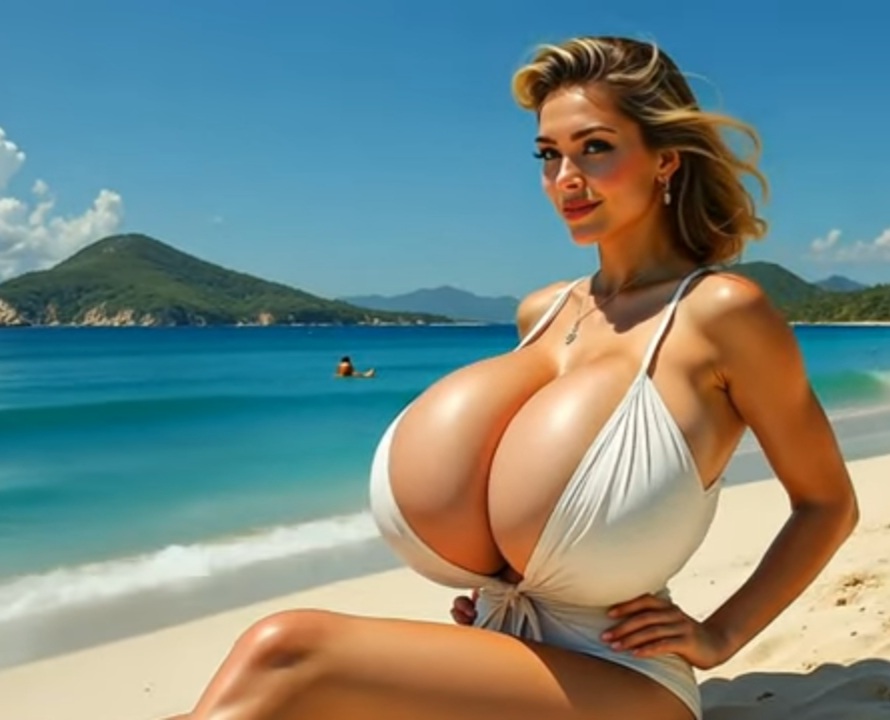 some mileage on her, could have as easily chosen a young virgin, παρθένος, who would still be, as he says, ὀρθότιτθος, orthótitthos, which the Loeb Classical library translates as "erect of breast."
some mileage on her, could have as easily chosen a young virgin, παρθένος, who would still be, as he says, ὀρθότιτθος, orthótitthos, which the Loeb Classical library translates as "erect of breast."
| Greek words for "breast" |
|---|
    |
    |
    |
    |
So I am at a loss to explain what has gone on with it. Ordinarily, there could be variant texts, or recensions, but I understand that there is only one copy the Secret History that survived. Liddell and Scott then give the definition "with outstanding breasts," which seems to be ambiguous, indicating either their uplifted firmness ("pert") or their aesthetic/erotic appeal. After all, the first element, ὀρθός, simply means "right, correct, straight," with similar ambiguity. See here.
Greek has another word, θηλή, which is just "teat, nipple," evidently from a verb, *θάω, "to suck, suckle," which no longer exists as an independent form -- but this does seem to be root of the Greek adjective for "female," θῆλυς, θήλεια, θῆλυ, which is examined here. But it also looks like τιτθός is from the same root, with a reduplicated first consonant. While we're at it, Sanskrit कुच, kuca, is specifically "female breast" and "nipple."
The Latin uber, "breast, teat, udder," of the Vulgate would be cognate to Greek οὖθαρ, oūthar, but what we find in the Septuagint is ἰδία, idía, "private" (feminine). So we have a euphemism, something like "let her privates satisfy you." We might as well go all the way with Monty Python and say "naughty parts." St. Jerome stuck to a more literal translation of Hebrew into Latin, in an age when we might have expected more squeamishness, not less.
But even the Latin word isn't quite what we expect. As it happens, the more familiar Latin mamma can mean "breast" in the simple and bi-sexual sense of "chest" -- although now in English, as a secondary meaning, "chest" itself can refer to breasts. Uber (neuter; genitive uberis, plural ubera) is more literally the mammary gland, as we might gather from the full citation. Similarly, the more familiar Greek μαστός (masculine) can also mean "chest," with οὖθαρ (neuter; genitive οὖθάρατος) carrying the more unambiguous reference -- indeed, it is the cognate, like uber, of the English word "udder," which, however, does not get used for human beings. We have already seen μαστός (masculine) in the dual as μαστώ. In the dual οὖθαρ is οὖθάρατε (plural οὖθάρατα). Why words for "breast, teat, nipple" should be in the neuter or masculine (τιτθός) gender is one of the little mysteries of language, for which various explanations about oppression probably can be constructed.
 |
|---|
However, since the "the pointlessly seedy Roman story of Old Cimon" is part of the common heritage of Christendom, Ghent is not the only place where we see it. At right is a detail from a painting, "The Seven Works of Mercy," Sette opere di Misericordia [1607], by Caravaggio (1571 1610). This was a painting for, and is still displayed in, a church, the Pio Monte della Misericordia, in Naples. This is suppposed to illustrate two different "works of mercy," both to "visit the imprisoned" and to "feed the hungry." Descriptions of the painting I have seen do seem to leave out the detail that the prisoner is the woman's father.
The idea that human breasts are sexual signals, and thus in part the result of Darwinian "sexual selection," which concerns the development of features that figure in mating, is unwelcome in some circles. We find this in Breasts, A Natural and Unnatural History, by Florence Williams [W.W. Norton & Company, 2012]. Williams is concerned that breasts be acknowledged for their primary function, lactation, and is worried about modern chemicals making their way into breast tissue and milk. This is largely a salutary and even laudable project -- although she does not note the irony that the first "industrial chemicals" she mentions for testing are "flame-retardants" [p.5], whose use, of course, is the result of tireless "consumer advocates" pushing laws that require their use. Is Williams aware that there are practical trade-offs between flame-retardant pajamas and the presence of chemicals that may pose other risks?
More germane to my concern here is her rejection of sexual-selection explanations, disparaged as "boobs-for-men," for the form that human breasts have taken. Although sexual selection theories go back to Darwin, but were not applied by him to human morphology, various anthropologists and feminists now have wanted to explain the peculiarities of human breasts, in comparison to those of other mammals, entirely in terms of the evolution of the needs and dynamics of lactation and breast feeding. As Williams says, "What's appealing about these woman-centered theories for the breast is that they make some attempt to understand how the organ actually works. The boobs-for-men theories do not" [p.32] -- as though function and sexual selection could not work at the same time.
Unfortunately, Williams consistently overlooks the circumstance that all the theories she cites are about "how the organ actually works" during lactation and breast-feeding, But Williams is reponding to an essential axiom of Feminism, that women do not need men and are better off without them -- as Gloria Steinem said, "A woman needs a man like a fish needs a bicycle." The corollary of this is consequently that breasts intrinsically have nothing to do with sex or men and that the penchant of men to stare at them is the result of "oppresssion," which is to say patriarchal cultural conditioning, or adverstising, or "consumerism" (i.e. capitalism), and so would vanish with properly elevated consciousness. As she says, "It turns out I wasn't the only woman whom Barnaby's work [on how often men look at breasts] made a little uncomfortable and self-conscious" [p.19].
The "boobs-for-men theories" are indeed about the sexual function of breasts, but the only aspect of sexual function that Williams considers is that of men looking. This is indeed a major sin in Feminism, that women are seen as sexual or aesthetic objects (with the powerful potential of their images useful in advertising). But Williams leaves out a major part of the sexual function of breasts, which is that men do not only look, they touch. And when they touch, women may become aroused.
As I note above, some women even report the ability to achieve orgasm titillatione mammarum. Somehow this does not make it into the account Williams gives, and it might even leave one wondering if Williams is at that end of the female spectrum where there is indeed not much sexual response from the breasts. Eventually, Williams does mention, in passing (in fact parenthetically), that "the breast is so sexually responsive" [p.53], but this is only in relation to the enervation that makes breasts "all the better for responding to infants" [ibid.].
So is she saying that she experiences a sexual response to breast feeding? Some women report this, others do not. Or is she saying that the sexual response is an accidental and incidental reflex, a sort of "false positive," of a pleasurable response to feeding babies? That would mean that Williams responds to a man's attention to her breasts, but she considers it illegitimate, a sort of (dubiously) positive externality or collateral damage, that should arouse the righteous suspicions of all of us. This seems a little confusing. But it gets a lot more confusing, or confused, with a later statement. She is describing how breast implants can damage the nerves and render nipples numb and so sexually insensitive. Thus, the attempt to render breasts more sexually attractive with implants, "actually eliminates the sexual feeling in this allegedly sexual organ" [p.81]. This is a very strange statement. On the one hand, it acknowledges that there is sexual feeling and a sexual response in breasts, but on the other hand Williams cannot forebear inserting "allegedly" into the characterization of the breast as a "sexual organ." So which is it? If the breasts are not sexual organs, a denial Williams apparently maintains, what is happening to them, and why should we care, that their (mythological?) sexual response is compromised? And if there is sexual feeling, which we do not want damaged by unnatural modifications like breast implants, does this not demonstrate that breasts are indeed sexual organs, and not just "allegedly" so?
Williams is hoist on the petard of the Feminist axiom. And Williams never does actually tell us to what extent she enjoys a sexual response from her own breasts -- a positive response from her own experience would perhaps (improperly) imply some truth to the "boobs-for-men" theory, although it would also mean "boobs-for-women" in terms of sexual pleasure. That's something else that gets left out here. Sexual selection isn't just for men. But even men can refute the "allegedly" when they discover the sexual response of the otherwise useless male nipple.
This merits some consideration. If Williams finds her own breasts devoid of sexual feeling, and thus feels justified in speaking for all women, or for female anatomy as such, in that respect, she nevertheless cannot then speak for men, whom she apparently does not consider, since there is no (non-pathological) male lactation. There is clearly more to all this than "fish needs a bicycle" Feminism. Williams is ignoring and suppressing a recognition and an account of the sexual response and consequently the role in mating, in both courtship and copulation, of the breasts. This goes deeper into the nature of Feminist ideology, which is an anaesthetic and anhedonic form of political moralism, i.e. something like the "Anti-Sex League" of Orwell's 1984.
What seems to make Williams uncomfortable is some overtone of the idea that sex with men is pleasurable. Even if she is happily married and experiences pleasure in sex, some features of this are filtered out of consciousness acknowledgement by her ideology. In the case of her treatment of the breast, not only the sexual function in visually attracting men is filtered out, but the pleasurable sexual response of breasts, even her own, is itself suppressed to the point of invisibility, with no more than grudging and incidental references. This is an extraordinary performance of the blindness of ideology and is sad and unfortunate in a book otherwise of some interest and value.
More importantly, is Williams not aware of the role of dominance in animal and primate societies? Does she think that dominance hierarchies were somehow missing from human interaction when human body shapes were evolving? Does Feminist orthodoxy rule out, a priori, for some kind of moral or political reasons, that the dynamics of dominance cannot figure in the deep past of human evolution? None of these interpretations really makes any sense. Williams, and the authorities her views reflect, want to apply a political prescription in the present, applied to culturally maleable modern societies, as a theoretical prescription to behavior in the evolutionary dynamic of nature, long before we have any evidence of cultural constructs that might be dismissed as arbitrary or socially oppressive.
Nature, indeed, is oppressive, which is why we hope that modern life can ameliorate its effects; but this cannot be an argument that the recognition of something like gender dominance in nature, which arguably is what Desmond Morris does, is somehow an embarrassment to right thinking people. Williams might have a better case with Creationists than with Darwinian Evolution, But, as I have said, Morris's observations actually need have no connection to gender dominance. A problem arises for Williams only because she doesn't like the idea that men enjoy looking at and touching women's breasts, or that in general women tend to like being looked at and touched. This is incommensurate with the revolutionary anhedonic morality promoted by Feminism. But that revolutionary morality is profoundly anti-humanistic, totalitarian, and anti-vital in its theoretical distortion. It reflects an ideological animus against joyous and sensual sexuality, which, as a suppression of what we might think would be fairly obvious features of erotic experience, betrays the unconscious potential of, indeed, the Jungian animus.
A curious case in this debate came to light in a letter to the Los Angeles Times some years ago. A young woman wrote to discuss her double radical mastectomy, which was a procedure in the news at the time (although I don't remember if the news item specifically had been the double radical mastectomy of Angelina Jolie, which it may have been). The young woman had a family history of breast cancer, and as she matured she developed rather large breasts. The striking thing about the letter was not just that the woman lived in some fear of breast cancer, which was understandable (my own mother, whose mother and grandmother both died young of breast cancer, had similar fears), but that she positively hated her breasts. They were just for men and constituted nothing but a (literal) burden and a danger for her. I think that anyone might agree with Florence Williams that this has carried the "boobs-for-men" idea rather too far. The young woman seemed to see her breasts as alien and evil. And then, as it happened, she was actually diagnosed with breast cancer, in light of which the argument for prophylactic mastectomies would become more reasonable. But she seemed glad to see them go, and not just because of the danger of disease. They were nothing good to her, not even, apparently, in terms of lactation.
The caution of this story is the danger of the mischaracterization of sexual selection by someone like Florence Williams. If the form of human breasts is due to sexual selection, this does not mean it is just for men. Indeed, if the whole surface of the breast is sexually sensitive, this has little to do with the male response to breasts. It may not occur to a man to caress the whole breast, perhaps thinking that only the nipples are sensitive, and it may be necessary for him to discover the larger response either by trial and error or by instruction -- with the circumstance, indeed, that not all women have this sensitivity. Enough women do, however, that it is more than reasonable to suppose, as human women became sexually responsive and available even outside ovulation (i.e. no true human estrus), their own enjoyment of their availability increased with sensitive breasts. Increased enjoyment would mean more eagerness for sex, and that would mean more reproduction. A winning Darwinian combination.
Philosophy of Science, Geology & Astronomy

Mammae Humanae, Note 4;
Sexual Selection

 while the sexual selection theories are about why the organs are the way they are entirely apart from pregnancy, lactation, and breast feeding -- i.e. "how the organ actually works" in the courting and mating actions of men and women -- for instance, that breasts are swollen, uniquely among mammals, when not lactating, and indeed when nulliparous. That is the curious thing about human breasts. Virgins dramatically display "boobs-for-men."
while the sexual selection theories are about why the organs are the way they are entirely apart from pregnancy, lactation, and breast feeding -- i.e. "how the organ actually works" in the courting and mating actions of men and women -- for instance, that breasts are swollen, uniquely among mammals, when not lactating, and indeed when nulliparous. That is the curious thing about human breasts. Virgins dramatically display "boobs-for-men."
 Does being stared at by men make Williams uncomfortable? But then she says that her breasts were never large enough to really attract stares. So if she is not being stared at, what is the complaint? But clearly something about this makes her uneasy. Perhaps the peacock's tail also makes her uneasy. Perhaps she is now obliged to explain to us what "function" the peacock's tail serves for the peacock, and how the peahens looking at the tails "oppress" the peacocks.
Does being stared at by men make Williams uncomfortable? But then she says that her breasts were never large enough to really attract stares. So if she is not being stared at, what is the complaint? But clearly something about this makes her uneasy. Perhaps the peacock's tail also makes her uneasy. Perhaps she is now obliged to explain to us what "function" the peacock's tail serves for the peacock, and how the peahens looking at the tails "oppress" the peacocks.

 But male nipples, however famously unnecessary, are nevertheless not inert. One might on the same grounds think the same of the female clitoris. But male nipples and female clitoris are erectile tissue, and they become sexually arroused and erect. And where the clitoris, corresponding as the homologous organ to the penis, is equally a center of sexual pleasure, male nipples, hard and erect, awaken and stimulate the penis. It would then be astonishing if female nipples, or the whole of the breasts, did not do the same. The lowly, inconspicuous, and disparaged male nipple thus manages to falsify an entire Williams thesis about breasts. Good work.
But male nipples, however famously unnecessary, are nevertheless not inert. One might on the same grounds think the same of the female clitoris. But male nipples and female clitoris are erectile tissue, and they become sexually arroused and erect. And where the clitoris, corresponding as the homologous organ to the penis, is equally a center of sexual pleasure, male nipples, hard and erect, awaken and stimulate the penis. It would then be astonishing if female nipples, or the whole of the breasts, did not do the same. The lowly, inconspicuous, and disparaged male nipple thus manages to falsify an entire Williams thesis about breasts. Good work.
 Ideology produces some other strange statements. Thus, speaking of the 1967 book by anthropologist Desmond Morris, Williams says, "Today, The Naked Ape reads like an embarrassing manifesto of male dominance" [p.25]. A number of questions occur about this. Why is it "male dominance" that men would be visually attracted to the female form? Does Williams mean to say that women do not want men attracted to them, or that attracted males are therefore "dominant"? Some might suggest that the power to attract males contributes to a potential for female dominance, just as the troubadors held that, while men were the lords in marriage, women were the lords in love. Either way, this again sounds like a reflex of Feminist anaesthesia and anhedonia.
Ideology produces some other strange statements. Thus, speaking of the 1967 book by anthropologist Desmond Morris, Williams says, "Today, The Naked Ape reads like an embarrassing manifesto of male dominance" [p.25]. A number of questions occur about this. Why is it "male dominance" that men would be visually attracted to the female form? Does Williams mean to say that women do not want men attracted to them, or that attracted males are therefore "dominant"? Some might suggest that the power to attract males contributes to a potential for female dominance, just as the troubadors held that, while men were the lords in marriage, women were the lords in love. Either way, this again sounds like a reflex of Feminist anaesthesia and anhedonia.
 since the former can imagine an anhedonic God designing breasts without courtship or sex in mind -- no "boobs-for-men" in Eden there. She also might worry that gender dominance is quite conspicuous in the under-class interactions that Theodore Dalrymple found in British public housing [Life at the Bottom, The Worldview That Makes the Underclass, Ivan R. Dee Publisher, Chicago, 2001] -- and that certainly is not missing in equivalent situations in the United States, France, etc.
since the former can imagine an anhedonic God designing breasts without courtship or sex in mind -- no "boobs-for-men" in Eden there. She also might worry that gender dominance is quite conspicuous in the under-class interactions that Theodore Dalrymple found in British public housing [Life at the Bottom, The Worldview That Makes the Underclass, Ivan R. Dee Publisher, Chicago, 2001] -- and that certainly is not missing in equivalent situations in the United States, France, etc.

 |
|---|
| Saint Agathe, 1630/1633, Francisco de Zurbarán (1598-1664), Musée Fabre, Montpellier, France; detail |
 That is not the intention.
That is not the intention.
However, there is a tradition of representing breasts on a plate, actually held by St. Agatha of Sicily (d.c.251 AD), who was tortured by, among other things, having her breasts removed. Saints are often shown with the instruments of their torture or the means of their deaths. Agatha was martyred by a Roman prefect during the persecution of Decius, mainly because he desired her, coming to use her Christianity just as a pretext. Since she was raped in prison, he presumably got his way, although mutiliating her body would probably spoil the appeal of further violations. Perhaps after the prefect lost interest, St. Peter is supposed to have appeared personally and healed Agatha's wounds.
Agatha is attested early, as soon as the sixth century, with mosaics of her from the Ostrogoth period in the Basilica of Sant'Apollinaire Nuovo in Ravenna; and she is supposed to be buried in Catania, Sicily,  where, of course, a yearly festival is held.
where, of course, a yearly festival is held.
The festival includes sweets, the Minne di Sant'Agata, as at left, in the shape of breasts, with a cherry on top. If we are to worry about the cult of Agatha representing the dismemberment of women, it would seem a whole new level of worry would be waranted, when we are invited to eat the breasts. The Museum of Sex in New York City has similar breasts toys, in appearance, but not as cakes or candy. However, the association of breasts with food does not seem so extraordinary.
Agatha is the Patron Saint of several locations in Sicily, Italy, Malta, and of Segovia in Spain. Agatha is also the Patron Saint of breast cancer patients, as we might imagine, rape victims, wet nurses, and, presumably because of the shape of their products, bellfounders, and bakers.
A November 2012 episode of the television show The New Girl featured a Lesbian couple. One of them asserted that the key to their relationship was, This is from a bit of fiction; but if it reflects the enthusiasm of some real Lesbians, it bespeaks the charm that Lesbians have always represented, that they like the same thing that I do, namely: Women. But this is the most enthusiastic endorsement of the sexual appeal of breasts that I have ever heard from any woman, gay or straight, real or fictional, for other breasts or their own. I am puzzled by how unusual that seems to be. On the other hand, there used to be a television show called Blind Date. In one show, the man and woman daters are being transported in a limo, and the woman has exposed her breasts (this can be seen on a DVD with images that could not be shown on broadcast television). The man is admiring them, and the woman comments, "They're just boobs; everybody has boobs." This is a curious statement. Not everyone, but only women, have "boobs"; and this woman belonged to a particular subset of women with relatively larger versions of them. Why would she be so dismissive of something that she has just gone out of her way to exhibit? It may be a sort of surface self-deprecation that is really the opposite. She knows how the man is going to respond. But somehow, it almost sounds sincere, that she is more than a little perplexed at the reaction she knows she is going to get.
In an other episode of The New Girl, the star, Zooey Deschanel, Oddly enough, a "boop-slap" may happen in the Iliad. Athena strikes Aphrodite, with her hand, on the breasts. See discussion here.
In more general use may be the expression "boob bouncing,"
The Wall Street Journal of June 17-18, 2017, features a book review under "Children's Books" by Meghan Cox Gurdon, for The Winged Girl of Knossos by Erick Berry [1934]. The image at the top of the feature, "Myth Meets Reality" [p.C10], is a drawing we see at left, which reproduces a fresco from Knossos. Part of this very fresco we have seen above, and at right. Noteworthy about this reproduced image is that we cannot tell that the women in it are bare breasted. But the minimal indication may be why this image was chosen to illustrate the book review. We don't want children to see that Cretan women were running around bare breasted. And the nipples are so lightly draw, we can just forget them. Viewers can be left to assume that the neckaces at the necklines also indicate the edge of some modesty preserving garment.
There is no doubt from this that breasts are still too hot to handle, as it were, in the American press. A common sight on Tokyo subways is a young man reading a telephone book sized comic book, which illustrates an alarming level of sexuality, where the rape of school girls just gets things warmed up. Indeed, the sexualization of school girls, So the large breasts in Japanese cartoons are a modern innovation, and, while one might wish to blame the influence of American movies, etc., such influence has proved resistable in, say, France, while the Japanese have taken it all up with gusto and made it their own, as they have with so many other things. There is no particular reason why they shouldn't, once we admit the inherent sexual role of breasts, for both men and women. It is a distinctive part of the Japanese version of this, however, in line with the school girl culture just mentioned, that the large breasted women have childish faces and unrealistically large eyes. Feminists are free to interpret all this as reflecting some sort of intrinsic paedophilia in Japanese culture; but, probably because it doesn't directly express any anti-American ideology, we hear little of the sort.
A possible connection between Germanic and Semitic languages is discussed by linguist John McWhorter [Our Magnificent Bastard Tongue, The Untold History of English, Avery, Penguin Random House, 2008, 2009]. McWhorter considers various peculiarities of the Germanic languages, from the unusual sound changes of Grimm's Law, to the loss of inflections (with both nouns and verbs), to the large amount of non-Indo-European vocabulary. All of these begin to look a bit like the sorts of influences and insults that English endured, as recounted earlier in McWhorter's book -- from the conquered Celtic population, Viking conquest and settlement, and the Norman conquest. How could proto-Germanic have had a similar experience? McWhorter recounts the theory of Theo Vennemann, of the University of Munich, that Phoenician colonization accounts for Semitic influence on Proto-Germanic [pp.190-193]. It is just possible that Phoenician traders reached what would have been the Germanic heartland in Scandinavia -- some scholars aren't convinced they even made it to Britain -- but even the occasional Phoenician ship would not be enough for the kind of presence that would have influenced the development of Germanic languages. There would need to be large scale colonization for that, something for which there is zero evidence and that pretty much defies the logic of the situtation. Phoencian colonies, where they certainly existed, rarely involved settlement reaching into the interior and overlapping the natives peoples of the area. Where that might have been most likely to happen, at Carthage, still left the native Berbers largely unaffected.
So I find this theory dubious. Given the Egyptian That would require something else, something more like the Celtic substrate that McWhorter thinks underlines English. Many of the "orphan" words in Germanic languages refer to the sea, including the word "sea" itself, along with "ship, sail, carp," and "eel." Since Indo-European languages are coming off the Steppe, they had no experience of such things. But if the Proto-Germans arrived in Scandinavia, with the North Sea on one side and the Baltic on the other, the indigenous people, whoever they were, would have had the experience and the words. They certainly didn't need to wait for Phoenicians, from the Eastern Mediterranean, to bring such words to them. And there must have been an indigenous people, such as we see with the now vanished Etruscans and the very much non-vanished Basques, whose languages were not Indo-European. Whether they were related to each other, with Etruscan poorly attested, we cannot say. But their works are evident, especially monumental ones from Malta to Stonehenge. I think that McWhorter overlooks that factor, as Vennemann must have also. Nevertheless, our suspicions of an Indo-European and Semitic connection need merely be pushed back further, perhaps to the point where Proto-Indo-European and Proto-Semitic may both have been within the orbit of the Caucasus Sprachbund. As we see at the link, we may wonder about phonetic commonalities, and the grammar of infixed vowels, which are common in Semitic languages but really only conspicuous with "strong" verbs in Indo-European languages -- where McWhorter mistakenly thinks that this is something unique to Germanic languages, overlooking the phenomenon in Greek and Sanskrit. Philosophy of Science, Linguistics It is going to be more difficult to be reconciled to organs that "just get in my way" when they become unnaturally large. This is condition called, among other things, "gigantomastia," a hypertrophy or overdevelopment of the breasts.
A familiar television personality suffered from this condition at puberty. Soleil Moon Frye (b.1976) first came to notice playing the eponymous star of the television series Punky Brewster (1984 1988). Child stars have a tough enough time, and not many of them do well in later life. As they mature, they may continue to look child-like, or after puberty they may simply not be good looking at all.
The success of the operation, and the impressive maturity of her looks, were on display in the television series, Sabrina, the Teenage Witch (2000 03), starring Melissa Joan Hart, which Frye joined after the beginning of its run. Having not seen Frye since Punky Brewster, the difference was stunning. It would have been impossible to guess that this person had been that child star. Subsequently, Frye seems to have concentrated on her family, voice work, directing, and some other hosting and non-fiction work. It is not clear why she did not continue with a more conventional acting career, unless it was a desire to preserve flexible time for her family, which now is going on four children.
Frye has made a documentary about her child star days, Kid 90 [2021], which features video that she shot at the time of all her friends and fellow actors. She also divulges that she lost her virginity to Charlie Sheen. Charlie Sheen! Well, I can't be too hard on him, since he was in one of the greatest movies ever made: Hot Shots! Part Deux [1993] -- also one of the last, great performances of Lloyd Bridges (1913-1998). For someone with gigantomastia, and no other gifts or abilities, a career in niche pornography might suggest itself. Howard Stern loves those women, most of whom, however, achieve grotesque breast sizes through implants, not as the result of a natural condition. Soleil Moon Frye, obviously, had no need of such a career, could not have done anything of the sort at her age, and was unwilling to endure the discomfort of the condition. This is easily understandable and sensible. However, the true breast fetishist is left vainly to wonder, "How big, really, were they?" It might seem like a loss to Nature that Frye didn't sacrifice her health and happiness at the dubious shrine of giant breasts -- or perhaps a genuine shrine in the terms we recollect from the paleolithic "Venus" figures -- There are some photos of the young Frye floating around, in shapeless garments, perhaps to conceal the size of her breasts; but, where nudes would be illegal, her clothed pictures give some idea of the extent of the hypertrophy. Certainly, Frye cannot want to be a focus of attention for that reason, and while there were splashy magazine articles at the time of her operation, references to it now are muted.
Katy Perry herself has voiced satisfaction with the aesthetics of her own breast development; and since she experiments with costumes and couture, cultivating a reputation as a fashionista, she has been mindful of how her endowment can be presented -- as we see above -- with a public persona far beyond what Soleil Moon Frye currently enjoys.

Mammae Humanae, Note 6

 "love, understanding, and two sets of boobs," to which her partner responded, "I love boobs; I love 'em; I loooove everything about 'em." Now, that's the right idea, although I would like to hear just what she loves about them.
"love, understanding, and two sets of boobs," to which her partner responded, "I love boobs; I love 'em; I loooove everything about 'em." Now, that's the right idea, although I would like to hear just what she loves about them.

 gets in an argument with her best friend, "Cece" (Hannah Simone). This results in a bit of a fight, where, instead of the familiar hair or clothes pulling often seen in fights between women, there was slapping, not of the face, but of the breasts. Since some drinking had been involved, Deschanel had trouble remembering exactly what had happened. But her breasts were sore. So she asked Cece, "Did you boob-slap me?" This was something I had never heard of before, and certainly had never actually seen. How common is such a thing? Something else puzzling in the story of breasts.
gets in an argument with her best friend, "Cece" (Hannah Simone). This results in a bit of a fight, where, instead of the familiar hair or clothes pulling often seen in fights between women, there was slapping, not of the face, but of the breasts. Since some drinking had been involved, Deschanel had trouble remembering exactly what had happened. But her breasts were sore. So she asked Cece, "Did you boob-slap me?" This was something I had never heard of before, and certainly had never actually seen. How common is such a thing? Something else puzzling in the story of breasts.
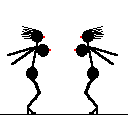 where two girls run at each other and bounce off each other's breasts. There are videos of this at YouTube. It looks potentially painful, perhaps even more so that "boob-slapping." Done slowly and safely, however, it looks like something to get the attention of any male within a thousand yards. Unclothed and in slow motion, the equivalent may be seen in countless pornographic films. The idea of what women might feel by rubbing their breasts against each other would be a source of endless curiosity among males.
where two girls run at each other and bounce off each other's breasts. There are videos of this at YouTube. It looks potentially painful, perhaps even more so that "boob-slapping." Done slowly and safely, however, it looks like something to get the attention of any male within a thousand yards. Unclothed and in slow motion, the equivalent may be seen in countless pornographic films. The idea of what women might feel by rubbing their breasts against each other would be a source of endless curiosity among males.

Mammae Humanae, Note 7


 In the original fresco, there is indeed minimal indication of this. All we see are very small nipples, which shows us that the curvature of the costume around the breasts is not over some sort of shirt or undergarment. If we are already familiar with Minoan costume, we don't need much to show us what we are looking at. This is typical.
In the original fresco, there is indeed minimal indication of this. All we see are very small nipples, which shows us that the curvature of the costume around the breasts is not over some sort of shirt or undergarment. If we are already familiar with Minoan costume, we don't need much to show us what we are looking at. This is typical.
 Minoan costume is certainly anomalous, but unlike the National Geographic, sexual scruples override historical accuracy and faithfulness in the modern editorial world of The Wall Street Journal. Also, there regularly are documentaries about Crete and Minoan civilization on cable channels, marveling at the palace at Knossos, the mythology of the Minotaur, etc. But these documentaries really never show images of Minoan female dress, or give any indication what it was like. Since the shows are often packed with images of Knossos, it comes to seem rather strange that frescos of women are scrupulously avoided. Then we may realize why. Female breasts are obscene to the modern sexual censors. At this point, we have not come very far from the 19th century in this.
Minoan costume is certainly anomalous, but unlike the National Geographic, sexual scruples override historical accuracy and faithfulness in the modern editorial world of The Wall Street Journal. Also, there regularly are documentaries about Crete and Minoan civilization on cable channels, marveling at the palace at Knossos, the mythology of the Minotaur, etc. But these documentaries really never show images of Minoan female dress, or give any indication what it was like. Since the shows are often packed with images of Knossos, it comes to seem rather strange that frescos of women are scrupulously avoided. Then we may realize why. Female breasts are obscene to the modern sexual censors. At this point, we have not come very far from the 19th century in this.

Mammae Humanae, Note 8;
Japanese Cartoons
 While conventional wisdom is that large breasts are an obsession of Americans, so that more sophisticated Europeans say that anything that can't fit into a champagne glass is wasted, large breasts were certainly the ideal in India, and no one could mistake their appeal after the most superficial inspection of Japanese cartoons, the manga comics and anime animations.
While conventional wisdom is that large breasts are an obsession of Americans, so that more sophisticated Europeans say that anything that can't fit into a champagne glass is wasted, large breasts were certainly the ideal in India, and no one could mistake their appeal after the most superficial inspection of Japanese cartoons, the manga comics and anime animations.
 in their distinctive uniforms, is a conspicuous feature of Japanese public culture, to an extent that would raise a storm of protest in the United States from the guardians of innocence, children, and morality, from Christians to Feminists. It seems to barely raise an eyebrow in Japan, where not long ago certain coffee shops, the no-pan kissa, offered waitresses in short skirts and no underwear moving over mirrored floors. It is hard to imagine such things in the United States, or even in much of Europe, without many of the cultural and political powers that be going ballistic. Nothing of the sort is remotely conceivable, meanwhile, in the Middle East.
in their distinctive uniforms, is a conspicuous feature of Japanese public culture, to an extent that would raise a storm of protest in the United States from the guardians of innocence, children, and morality, from Christians to Feminists. It seems to barely raise an eyebrow in Japan, where not long ago certain coffee shops, the no-pan kissa, offered waitresses in short skirts and no underwear moving over mirrored floors. It is hard to imagine such things in the United States, or even in much of Europe, without many of the cultural and political powers that be going ballistic. Nothing of the sort is remotely conceivable, meanwhile, in the Middle East.
 Be that as it may, the curious thing about the large breasts we see in manga and anime is that there was not much emphasis placed on breasts in traditional Chinese or Japanese erotica (such as explored by Robert van Gulik), and Chinese or Japanese women are not generally well known as having particularly large breasts themselves. Indeed, traditional Japanese dress binds the chest to an extent that large breasts would be crushed.
Be that as it may, the curious thing about the large breasts we see in manga and anime is that there was not much emphasis placed on breasts in traditional Chinese or Japanese erotica (such as explored by Robert van Gulik), and Chinese or Japanese women are not generally well known as having particularly large breasts themselves. Indeed, traditional Japanese dress binds the chest to an extent that large breasts would be crushed.

Mammae Humanae, Note 9;
The Semitic-Indo-European Connection

 , the Arabic malaja, مَلَجَ, and so the Proto-Semitic *mlg, we can speculate a connection to English "milk" and Proto-Germanic *melkan, but this also looks like Latin mulgere and so Proto-Indo-European *melg. But a Proto-Indo-European root contradicts the thesis of Phoenican colonization, which is partially built on "orphan" Germanic roots that are not Indo-European, but look Semitic -- like "fright," German Furcht, which could be the Proto-Semitic *prḫ, "to fear," with the twist that Carthaginians would have pronounced the p as f, with a Grimm's Law sort of sound change [pp.183-184,193]. Such words might be picked up from Phoenician traders, without thereby influencing the language to the extent imagined by Vennemann.
, the Arabic malaja, مَلَجَ, and so the Proto-Semitic *mlg, we can speculate a connection to English "milk" and Proto-Germanic *melkan, but this also looks like Latin mulgere and so Proto-Indo-European *melg. But a Proto-Indo-European root contradicts the thesis of Phoenican colonization, which is partially built on "orphan" Germanic roots that are not Indo-European, but look Semitic -- like "fright," German Furcht, which could be the Proto-Semitic *prḫ, "to fear," with the twist that Carthaginians would have pronounced the p as f, with a Grimm's Law sort of sound change [pp.183-184,193]. Such words might be picked up from Phoenician traders, without thereby influencing the language to the extent imagined by Vennemann.


Mammae Humanae, Note 10

 This turned out not to be a problem for Soleil Moon Frye, who matured from a very cute kid into a very good looking adult. That is not where her problem at puberty lay. Instead, she developed gigantomastia, which was severe enough that it imposed painful stresses on her back and elsewhere. The solution to this was breast-reduction surgery, which was performed before her sixteenth birthday.
This turned out not to be a problem for Soleil Moon Frye, who matured from a very cute kid into a very good looking adult. That is not where her problem at puberty lay. Instead, she developed gigantomastia, which was severe enough that it imposed painful stresses on her back and elsewhere. The solution to this was breast-reduction surgery, which was performed before her sixteenth birthday.

 like the "Venus of Willendorf" in the Naturhistorisches Museum in Vienna -- which consist mostly of enormous breasts and buttocks, at the cost of inessentials like faces, hands, and feet.
like the "Venus of Willendorf" in the Naturhistorisches Museum in Vienna -- which consist mostly of enormous breasts and buttocks, at the cost of inessentials like faces, hands, and feet.